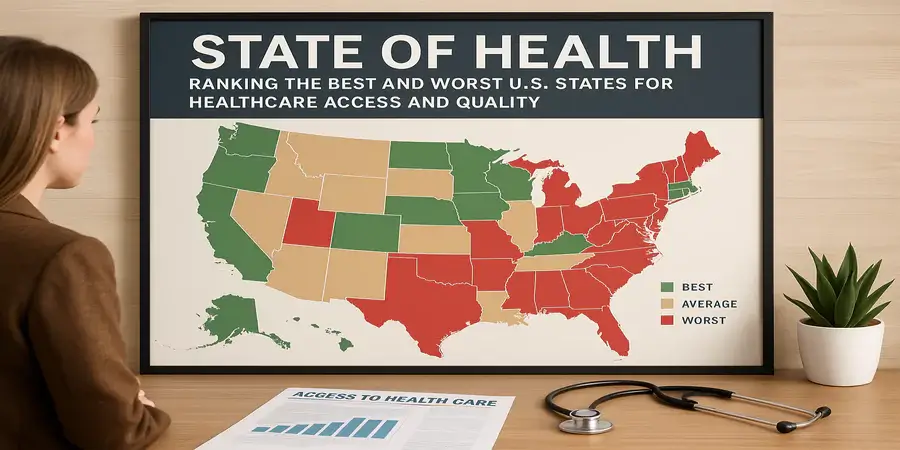Access to quality healthcare is a fundamental aspect of well-being. Whether it’s for preventive care, managing chronic conditions, or receiving emergency treatment, the ability to access reliable healthcare services directly influences health outcomes. In the United States—despite its reputation for medical innovation—healthcare systems vary significantly from state to state. This leads to considerable differences in both the accessibility and quality of care.
In this article, we explore which states lead in healthcare delivery and which ones lag behind, based on factors like insurance coverage, healthcare infrastructure, public health outcomes, and the availability of skilled professionals.
Understanding the Concepts: Healthcare Access vs. Healthcare Quality
Before diving into state rankings, it’s important to define what we mean by healthcare access and healthcare quality.
What is Healthcare Access?
Healthcare access refers to the ease with which residents can receive medical services. This includes having enough hospitals, clinics, and doctors, along with adequate insurance coverage and transportation options. Affordability is another key component.
What is Healthcare Quality?
Healthcare quality involves the effectiveness of care provided. This includes treatment success rates, patient safety, satisfaction, and access to modern medical technologies. Quality is often reflected in long-term health outcomes such as life expectancy and chronic disease management.
Factors Influencing Healthcare Performance Across States
Several core elements affect how well healthcare systems perform:
- Insurance Availability: Higher coverage rates lead to better healthcare utilization.
- Medical Infrastructure: An ample supply of facilities and healthcare professionals ensures timely care.
- Public Health Metrics: States with lower rates of chronic illnesses and better maternal/infant health tend to rank higher.
- Health Equity: Equal care for all demographics—regardless of income, race, or location—is critical to overall performance.
Top 5 Best U.S. States for Healthcare Access and Quality
- Massachusetts
Massachusetts frequently ranks among the top for its expansive healthcare system and low uninsured rate.
Why It Stands Out
- Implemented an early form of universal health coverage
- Home to leading medical institutions like Massachusetts General Hospital
- High patient satisfaction and positive treatment outcomes
- Minnesota
Known for its robust public health initiatives and preventive care programs, Minnesota offers excellent health services across rural and urban areas.
Key Strengths
- Focus on wellness and early intervention
- High life expectancy and efficient healthcare spending
- Equitable distribution of providers
- Hawaii
Hawaii blends accessibility and health outcomes thanks to its unique employer-mandated insurance model.
Notable Highlights
- Among the lowest uninsured rates in the country
- High life expectancy and excellent maternal care
- Strong public health infrastructure
- California
Despite its large population, California has successfully expanded coverage and leads in healthcare innovation.
What Sets It Apart
- Medicaid expansion under the ACA has reduced uninsured rates
- Renowned institutions like Stanford Health Care and UCLA Medical Center
- Strong digital health and medical research presence
- Connecticut
Connecticut boasts a strong network of hospitals, comprehensive insurance coverage, and proactive community health programs.
Why It Ranks High
- Low uninsured rates
- Advanced chronic disease management programs
- Effective implementation of ACA reforms
Bottom 5 U.S. States Struggling with Healthcare Access and Quality
- Mississippi
Mississippi faces systemic challenges across its healthcare system, ranking low in both access and outcomes.
Core Issues
- High percentage of uninsured residents
- Limited healthcare facilities, especially in rural areas
- Elevated rates of obesity, diabetes, and preventable conditions
- Louisiana
Louisiana’s healthcare services suffer from underfunding and uneven distribution of providers.
Key Problems
- Insufficient mental health and addiction services
- High infant mortality rates and chronic disease prevalence
- Significant disparities in care for low-income communities
- Alabama
Alabama’s healthcare system continues to underperform, largely due to policy decisions and infrastructure gaps.
Primary Challenges
- Medicaid expansion not adopted, leading to more uninsured residents
- Rural healthcare professional shortages
- High rates of preventable hospitalizations
- West Virginia
High poverty rates and substance abuse issues contribute to West Virginia’s low healthcare rankings.
Concerns
- Elevated rates of smoking and opioid addiction
- Shortages in healthcare providers, especially in remote areas
- Poor chronic disease management
- Arkansas
Despite improvements in coverage, Arkansas continues to battle healthcare delivery challenges.
Factors at Play
- High rates of cardiovascular issues and obesity
- Limited access to specialists
- Incomplete Medicaid coverage expansion
Key Takeaways: Comparing the Best and Worst States
- Insurance Matters: States like Massachusetts and Connecticut with higher insurance rates show better outcomes.
- Infrastructure and Innovation Help: California’s leadership in healthcare technology gives it a significant edge.
- Prevention is Powerful: States focusing on wellness and prevention, like Minnesota and Hawaii, achieve better public health results.
- Policy Decisions Have Consequences: States that have not expanded Medicaid, such as Alabama and Mississippi, continue to struggle with coverage gaps and lower outcomes.
- Rural Access is Crucial: Many low-ranking states share a common challenge—limited access in rural regions, affecting care continuity and timeliness.
A Vision for the Future: Building a Healthier Nation
The state of healthcare in the U.S. is marked by deep inequalities and varied performance. However, progress is possible. The road to improvement lies in expanding insurance coverage, investing in healthcare infrastructure, and committing to equitable care across all communities.
By learning from top-performing states and prioritizing reform in struggling regions, we can bridge the healthcare divide and work toward a system that delivers high-quality, accessible care for every American.




